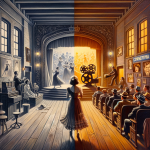Now Reading: A Journey Through Gentrification: Insights from The Landlord
-
01
A Journey Through Gentrification: Insights from The Landlord
A Journey Through Gentrification: Insights from The Landlord

A Journey Through Gentrification: Insights from The Landlord
In the realm of cinema, few films manage to weave social commentary with storytelling as adeptly as The Landlord, a movie featuring the talented Beau Bridges and Pearl Bailey. Released in the early 1970s, this film does not merely entertain; it sheds light on critical social issues, particularly the theme of gentrification in the historically rich neighborhood of Park Slope, Brooklyn. In this blog post, we’ll delve into the intricate themes of the film, the impact of gentrification, and its relevance in today’s context.
Understanding Gentrification
Gentrification is a complex and often controversial phenomenon that refers to the transformation of urban neighborhoods through the influx of wealthier residents. This process can lead to significant economic revitalization, but it also brings about social displacement and loss of cultural identity for long-time residents. Here are some key aspects to consider:
- Economic Impact: Increased property values and cost of living can push out lower-income families.
- Cultural Shifts: The original community’s identity may erode as new businesses cater to wealthier residents.
- Social Tension: Conflict can arise between new and existing residents, leading to a polarized community atmosphere.
The Landlord: A Film Analysis
The Landlord serves as a poignant narrative reflecting the gentrification process. The protagonist, played by Beau Bridges, embarks on a journey of self-discovery amid the changing landscape of Park Slope. His relationship with tenants, including the formidable character portrayed by Pearl Bailey, exposes the struggles and realities faced by those affected by gentrification.
Key Themes in The Landlord
- Conflict of Class and Race: The film presents a multi-layered perspective on the intersections of class and race, showcasing how different socioeconomic backgrounds interact within the same space.
- Search for Identity: The protagonist’s journey reflects a quest for personal and community identity amidst external pressures to conform to new realities.
- Human Connections: At its core, the film emphasizes the importance of understanding and empathy in a rapidly changing world.
Relevance of The Landlord Today
As we navigate the complexities of urban living in the 21st century, the themes presented in The Landlord resonate with modern audiences. Gentrification remains a pressing issue in many cities, prompting discussions on affordable housing, community preservation, and social justice. The film invites viewers to reflect on their roles and responsibilities within their communities.
To summarize, The Landlord is more than just a cinematic experience; it is a profound commentary on the social dynamics of urban life. By exploring gentrification through the lens of relatable characters and narrative conflicts, the film encourages a deeper understanding of the challenges and triumphs faced by diverse communities.
Conclusion
Whether you are a film enthusiast, a sociologist, or simply someone interested in the evolution of urban spaces, The Landlord provides valuable insights into gentrification and its impacts. Reflecting on the film can help foster discussions about current societal changes and inspire action toward community engagement and advocacy.
Stay Informed With the Latest & Most Important News
Previous Post
Next Post
-
 01Famous Writers from Brooklyn, New York
01Famous Writers from Brooklyn, New York -
 02A Comprehensive Look at Famous Novelists from Brooklyn, New York
02A Comprehensive Look at Famous Novelists from Brooklyn, New York -
 03The Impactful Journey of Donald Joel Aronow: A Boat Design Pioneer
03The Impactful Journey of Donald Joel Aronow: A Boat Design Pioneer -
 04A Scenic Journey: The Staten Island Ferry from Brooklyn to Manhattan
04A Scenic Journey: The Staten Island Ferry from Brooklyn to Manhattan -
 05Famous Sports Stars from Brooklyn, New York
05Famous Sports Stars from Brooklyn, New York -
 06A Look Back at the 1977 Brooklyn Blackout: Causes and Impacts
06A Look Back at the 1977 Brooklyn Blackout: Causes and Impacts -
 07A Comprehensive Look at Barry Manilow’s Brooklyn Roots
07A Comprehensive Look at Barry Manilow’s Brooklyn Roots

































